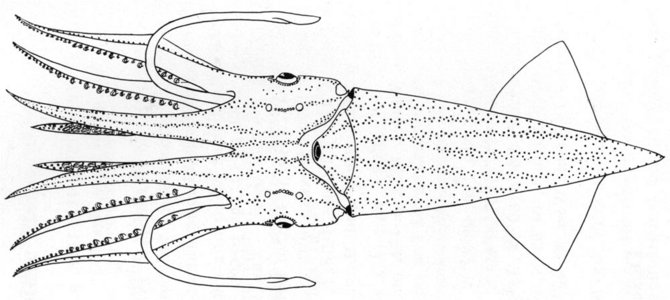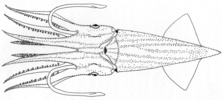Enoploteuthis leptura
Richard E. Young, Clyde F. E. Roper, and Kotaro TsuchiyaCharacteristics
- Arms
- Arm hooks on arms I-III (45-79 mm ML): 22-27.
- Arm hooks on arms IV (45-79 mm ML, male and female): 32-39.
- Males with numerous, minute papillae over oral surfaces of arms I-III.
- Hectocotylus: Right arm IV with expanded ventral protective membrane (=flap) in distal third of arm opposite about 6 pairs of hooks. Dorsal protective membrane expands slightly into a series of small flaps opposite the large flap of the ventral membrane.
- Tentacles
- Tentacles short, thin.
- Clubs not expanded. Manus with 2 series of hooks: ventral series with 6-7 larger hooks, dorsal series with 4-5 smaller hooks. Dactylus with suckers in two series totalling 10-15 suckers. Carpal cluster long and narrow.
- Integumental photophores
- Ventral mantle with six complex photophore series anteriorly. A seventh series in ventral midline doesn't reach anterior mantle margin but curves to join one nearby medial series to either the right or left. Ventral, anterior margin of mantle with discontinuous row of photophores; gaps correspond to spaces between photophore series on mantle.
- Ventral head with six photophore series (excluding eyelid series). Lateral-most series broken by ventral window in skin. No photophores present between the latter and the eyelid series.
Comments
The above description is from Roper (1966).
Life History
Age and growth
Based on statolith increments, E. leptura in Gulf of Guinea shows early maturation of males (at age 45-60 days) and females (at 80-90 days). Maximum age is 153 days in mature males of 72 mm DML, and 143 days in mature females of 92 mm DML (Arkhipkin, 1994).
Spawning
In the Gulf of Guinea, two peaks of spawning were recognized between January and September (Arkhipkin, 1994).
Distributiion
Type locality - Tropical Atlantic Ocean off West Africa at 01°08'N, 07°26'30"E.
Geographical distribution - Tropical Atlantic from Bermuda and Madeira to Brazil and southwestern Africa (Nesis, 1982/87).
References
Arkhipkin, A.I. 1994. Age, growth and maturation of the squid Enoploteuthis leptura (Oegopsida: Enoploteuthidae) form the central-east Atlantic. Journal of Molluscan Studies, 60:1-8.
Nesis, K. N. 1982. Abridged key to the cephalopod mollusks of the world's ocean. 385+ii pp. Light and Food Industry Publishing House, Moscow. (In Russian.). Translated into English by B. S. Levitov, ed. by L. A. Burgess (1987), Cephalopods of the world. T. F. H. Publications, Neptune City, NJ, 351pp.
Roper, C.F.E., 1966. A study of the genus Enoploteuthis (Cephalopoda: Oegopsida) in the Atlantic Ocean with a description of the type species, E. leptura (Leach, 1817). Dana Report, 66:1-46.
Title Illustrations

| Scientific Name | Enoploteuthis leptura |
|---|---|
| Location | Northeastern Atlantic off West Africa. |
| Reference | Roper, C.F.E., 1966. A study of the genus Enoploteuthis (Cephalopoda: Oegopsida) in the Atlantic Ocean with a description of the type species, E. leptura (Leach, 1817). Dana Report, 66:1-46. |
| Sex | Female |
| View | Ventral |
| Size | 45 mm ML |
| Copyright | © 1966 Carlsberg Foundation |
About This Page
Richard E. Young

University of Hawaii, Honolulu, HI, USA
Clyde F. E. Roper

Smithsonian Institution, Washington, D. C., USA
Kotaro Tsuchiya

Tokyo University of Fisheries, Tokyo, Japan
Page copyright © 2015 Richard E. Young , Clyde F. E. Roper , and Kotaro Tsuchiya
 Page: Tree of Life
Enoploteuthis leptura .
Authored by
Richard E. Young, Clyde F. E. Roper, and Kotaro Tsuchiya.
The TEXT of this page is licensed under the
Creative Commons Attribution-NonCommercial License - Version 3.0. Note that images and other media
featured on this page are each governed by their own license, and they may or may not be available
for reuse. Click on an image or a media link to access the media data window, which provides the
relevant licensing information. For the general terms and conditions of ToL material reuse and
redistribution, please see the Tree of Life Copyright
Policies.
Page: Tree of Life
Enoploteuthis leptura .
Authored by
Richard E. Young, Clyde F. E. Roper, and Kotaro Tsuchiya.
The TEXT of this page is licensed under the
Creative Commons Attribution-NonCommercial License - Version 3.0. Note that images and other media
featured on this page are each governed by their own license, and they may or may not be available
for reuse. Click on an image or a media link to access the media data window, which provides the
relevant licensing information. For the general terms and conditions of ToL material reuse and
redistribution, please see the Tree of Life Copyright
Policies.
- First online 23 July 2009
- Content changed 23 July 2009
Citing this page:
Young, Richard E., Clyde F. E. Roper, and Kotaro Tsuchiya. 2009. Enoploteuthis leptura . Version 23 July 2009 (under construction). http://tolweb.org/Enoploteuthis_leptura/19722/2009.07.23 in The Tree of Life Web Project, http://tolweb.org/










 Go to quick links
Go to quick search
Go to navigation for this section of the ToL site
Go to detailed links for the ToL site
Go to quick links
Go to quick search
Go to navigation for this section of the ToL site
Go to detailed links for the ToL site